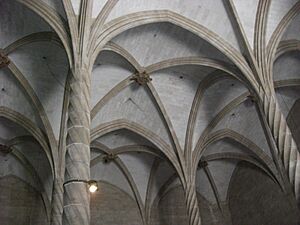Guillem Sagrera facts for kids
Guillem Sagrera (born around 1380 in Felanitx, Mallorca; died 1456 in Naples) was a famous Gothic sculptor and architect. He was from the island of Mallorca.
Sagrera was known for creating beautiful sculptures and designing impressive buildings. He worked on many important projects during his life.
Contents
Who Was Guillem Sagrera?
Guillem Sagrera was born in a town called Felanitx on the island of Mallorca. This was around the year 1380. He grew up to become a very skilled artist and builder.
He specialized in the Gothic style. This was a popular way of building and decorating during the Middle Ages. Gothic buildings often have tall arches, pointed windows, and detailed sculptures.
Early Career and Major Works
In the early 1400s, Sagrera became the main architect for the Cathedral of Perpignan. This city was part of the Kingdom of Mallorca at that time. He helped design and build parts of this large church in the late-Gothic style.
He also worked on the La Seu Cathedral in Palma de Mallorca. This is another grand church where he was in charge of the building work. His skills helped shape these important religious buildings.
His Masterpiece: The Llotja dels Mercaders
One of Sagrera's most famous buildings is the Llotja dels Mercaders. It is located in Palma, Mallorca. This building was constructed between 1426 and 1447.
The Llotja dels Mercaders was a trade hall. It was a place where merchants met to do business. Many people consider it his greatest work. It shows off his amazing talent for Gothic architecture.
Working for the King in Naples
Later in his life, Guillem Sagrera moved to Naples. He worked for King Alfonso V of Aragon. The king hired him to help with a big project.
Sagrera was tasked with fixing up the Castel Nuovo. This is a large castle in Naples. He changed its design and added new parts. He included several loggias, which are open-sided galleries. He also designed the Barons' Hall. This was a grand room inside the castle.
Guillem Sagrera passed away in Naples in 1456. His work left a lasting mark on the architecture of his time.
See also
 In Spanish: Guillem Sagrera para niños
In Spanish: Guillem Sagrera para niños



